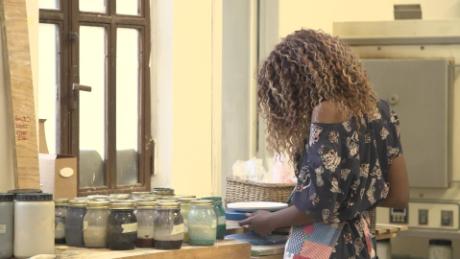‘Tortured and held for ransom,’ a child migrant’s story

Souleiman says he left home in the summer of 2016, traveling thousands of miles through Mali, Algeria and Libya before reaching the Mediterranean Sea in December 2017. Smugglers put him in a dinghy along with other migrants bound for Italy, but then left it stranded off the coast of Libya with no engine and no paddle. He was picked up by a rescue ship operated by humanitarian organization Proactiva Open Arms, one of 695 migrants it rescued in the space of a week. "I had no choice but leaving [Guinea]," he told CNN, onboard the ship. "Ebola exterminated all my family. My dad, my mum and my two brothers. I was left with my older sister and my little brother."Related: Migrants tell of brutality in LibyaSouleiman said that at each stage of his journey through Mali and Algeria, he had to find the money to pay for the next step. But as he tried to cross into Libya, he said he was sold and bought, as if he were merchandise, by gangsters in the city of Bani Walid. Their business: extorting money from defenseless migrants."The driver that brought us from Algeria to Libya had negotiated with some Libyans who own prisons, to sell us … He brought us directly to the prison," said Souleiman."In the prison, they beat you every morning. You can stay for days without eating. They connect you to the electricity."More: Migrant slave auctions in LibyaAfter several months of torture, he says he was released, thanks to a payment of $1,000 made by his family. But he says that hundreds of other migrants were left behind, many still in prison.
Vulnerable children
All migrants traveling this Central Mediterranean route are at risk of exploitation, but those between the ages of 14 and 17 are most vulnerable, with nearly nine in 10 of them exposed to human trafficking, according to the International Organisation for Migration (IOM).UNICEF estimates that 15 – 20% of all migrants arriving in Italy are children, and that 90% of those children are unaccompanied. "The majority of children on the move on the Central Mediterranean route to Italy are coming from west Africa and some from east Africa," explained UNICEF spokesperson Sarah Crowe."We know from studies that it is not always their initial intention to come to Europe. Their initial intention is just to leave home. It is often because of trouble or violence at home, or hope for a better education or because in fact traffickers and smugglers are offering them the pretense of better opportunities elsewhere. "They sometimes use social media to lure young people, to pretend there's a paradise waiting for them with jobs and freedom."
Migrant repatriations
The UN and European Union say they have been taking steps to help migrants.The EU says it worked with the UN on the voluntary repatriation of more than 15,000 migrants on the Central Mediterranean route in 2017. In December 2017, the UN began mass evacuations from Libyan detention centers. It says more than 1,000 refugees have been evacuated in the three months since the start of the operation.Still, UNICEF is calling for EU leaders to protect children by establishing safe and legal migration pathways and protection corridors.More from the CNN Freedom Project"They need to be treated as children before they are seen as migrants and refugees," said Crowe. "They should not be detained because of their migration status, which is happening in huge numbers in Libya. They need to be appointed guardians who can help them navigate a bewildering world of rules and regulations."It's about giving them a protective environment every step of the way and making sure the authorities see them as children who have the same rights to education and healthcare, and care, that any child should have."
In December 2017, the UN began mass evacuations from Libyan detention centers. It says more than 1,000 refugees have been evacuated in the three months since the start of the operation.Still, UNICEF is calling for EU leaders to protect children by establishing safe and legal migration pathways and protection corridors.More from the CNN Freedom Project"They need to be treated as children before they are seen as migrants and refugees," said Crowe. "They should not be detained because of their migration status, which is happening in huge numbers in Libya. They need to be appointed guardians who can help them navigate a bewildering world of rules and regulations."It's about giving them a protective environment every step of the way and making sure the authorities see them as children who have the same rights to education and healthcare, and care, that any child should have."
Original Article
[contf] [contfnew] 
CNN
[contfnewc] [contfnewc]



